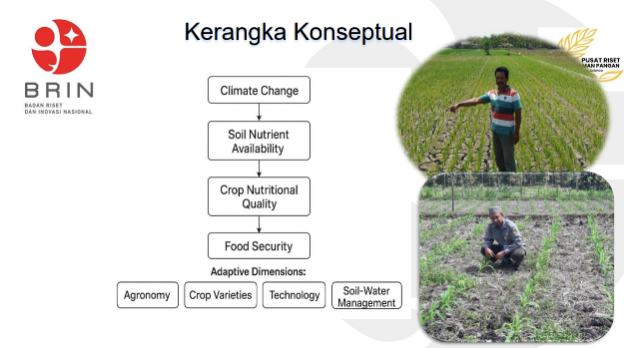Climate Change Does Not Only Threaten Food Production But Also Crop Nutrition
Authors: Michelle Nova Lauwrhetta, Ibnu Budiman
Indonesia: 7th/Nov/2025
Authors: Michelle Nova Lauwrhetta, Ibnu Budiman
Indonesia: 7th/Nov/2025
On October 14, 2025, the 5th series of Bincang Pangan Sehat Lestari brought together experts, policymakers, and practitioners from government agencies and NGOs. The discussions focused on the impact of climate change on food crop nutrition.
As part of the discussion, GAIN Indonesia presented results of research on two main pathways of climate change impacting crop nutrition: rising CO2, and climate variabilities and its impacts. Rising CO2 in the atmosphere causes a decrease in the nutrient content of food crops. For example, research by Taub et al. (2007) indicates there is a 10 to 15 percent decrease in protein concentrations in wheat, rice, and potatoes. Beyond the CO2 effect, climate extremes themselves compromise nutritional value. Tighceelar et al. (2024) estimate that by mid-century, supplies of 75% of calcium, 30% of folate, 39% of iron, and 68% of vitamin A are projected to face climate extremes at least every other year globally. This has the potential to cause a high-calorie but nutrient-poor diet, which is projected to increase the risk of obesity and diabetes in the long term.

Talk show session with Franky Zamzani, S.Hut, M.Env from the Ministry of Environment (KLH), Maria Ulfa, S.Si from the Ministry of Agriculture, Dr. Betha Lusiana from CIFOR-ICRAF, and Ahmad Suriadi, S.P., M.Agr.Sc., Ph.D from National Research and Innovation Agency (BRIN)
Franky Zamzani, Director of Climate Change Adaption at the Ministry of Environment, stated: “Indonesia is an archipelagic country, highly vulnerable to climate change. These conditions pose many serious risks, including a decline in food production that will directly affect food supplies, which could ultimately lead to food insecurity and a decline in the nutritional status of the population.”
Ahmad Suriadi from the Food Crops Research Center, BRIN, added - “increased CO2 can reduce protein and micronutrients like zinc and iron in wheat from dry land up to 15-20%.” He also noted that drought and flooding can affect nutrient mobility in the soil. Furthermore, high temperatures can alter plant metabolism, including the synthesis of vitamins and phytonutrients. Lastly, increased salinity can reduce the availability of calcium, potassium, and magnesium.

Ahmad Suriadi from BRIN explained climate impacts on crop nutrition
As a follow-up to the Paris Agreement, the government, through the Ministry of Environment, is currently drafting the Indonesia National Adaptation Plan, which will be integrated into national and sub-national policies.
The Ministry of Environment is currently running PROKLIM (Community Program for Climate), a national initiative that aims to increase community and stakeholder involvement in strengthening capacity to adapt to the impacts of climate change and reduce greenhouse gas emissions. This is achieved through actions such as the diversification of food crops and the selection of climate-resilient commodities to protect nutrient content against rising temperature and CO2. Furthermore, PROKLIM promotes local food preservation and utilises systems like Urban Farming and Vertical Gardens to ensure a sustained supply of diverse, nutrient-rich foods at the community level. This program has been implemented in 12.616 locations (2012-2025) with 62 mentors, 41 supporters, and 1,327 implementers. However, the program did not include measures that directly address climate impacts on crop nutrition.
Maria Ulfa, from the Drought Impact Mitigation and Adaption Working Team at the Ministry of Agriculture, emphasized that the interaction between climate and food and nutrition is two-sided. Our food system itself significantly contributes to climate change, primarily through agricultural practices that release greenhouse gases (GHGs). However, it is simultaneously highly vulnerable to the consequences of the climate change it helps cause, leading to reduced crop yields, lower nutrient content, and increased food insecurity.
Although the government is promoting “Swasembada Pangan” to ensure the availability of staple foods, increased crop production often goes hand in hand with high GHG emissions. Therefore, the Ministry of Agriculture is undertaking several measures to ensure the agricultural sector continues to operate without causing excessive GHG emissions. Some of the efforts being made include water conservation,, implementing no-burn tillage, promoting use of low-emission varieties, reducing chemical fertilizer use, and the control of environmentally friendly plant pests.
Ahmad Suriadi highlighted a promising solution – Biofortification. However, to ensure effectiveness, current government biofortification programs need to critically consider the climate impacts, such as increased CO2, drought, high temperatures, and salinity, negatively affect the content of protein, zinc, iron, vitamins, phytonutrients, calcium, potassium, and magnesium in crops.
Dr Betha Lusiana, a speaker from CIFOR-ICRAF, asserted that to effectively address the impact of climate change on crop nutrition, broader efforts are needed, with food diversification being a key adaptation action. Diversifying food sources helps communities adapt to shifting climate conditions by ensuring stable access to nutrients even when certain crops are affected by droughts, floods, or declining productivity. Indonesia has a wealth of local foods with great potential for utilisation. These local resources offer multiple advantages: they facilitate food consumption diversification, reduce dependence on rice, lower carbon footprints, and provide natural resilience to climate change. Research supporting this approach shows that the use of local foods in community interventions, such as kitchen gardens and nutrition education, has successfully increased nutrient consumption in communities in 36 villages in South Sulawesi, South Sumatra, and East Nusa Tenggara.
Ahmad Suryadi also provided several additional adaptations measures for strengthening crop quality. With advances in technology, farmers are also encouraged to implement Smart Farming and Climate Smart Agriculture. There are several tools that can be used, such as Dry Soil Test Devices to quickly measure nutrient levels, and Paddy Soil Test Kits to analyze soil chemistry. In addition, farmers can also implement the Internet of Things (IoT) to help with soil moisture sensors, monitor plant health, and maintain plant nutrient quality in real time.
The event highlighted the importance of both policymakers and practitioners, being more aware of climate change impacts to nutritional content of food crops and implement comprehensive solutions. This collective effort is important to prevent the worsening of climate change while simultaneously maintaining the nutritional content of food crops in Indonesia for national food and nutrition security.
Achieving true food security must be aligned with addressing malnutrition issues. This connection highlights that a food system is only resilient if the food it produces is both sufficient in quantity and adequate in quality. Consequently, nutrition security is also important and necessary component of climate adaptation.
Bincang Pangan Sehat Lestari (BPSL) is a series of talk shows created by GAIN, in collaboration with the Indonesia Post-Harvest Loss Alliance for Nutrition (JP2GI). This program is part of policy advocacy for environment, climate, and nutrition integration in three targeted policies on food-based dietary guidelines, food procurement, and climate action.
In this series, attendees gained insightful perspectives on National Climate Change Adaption Policy from Franky Zamzani, S.Hut., M.Env (Ministry of Environment), The Impact of Climate Change on Food Crops from Maria Ulfa, S.Si (Ministry of Agriculture), Local Food for Food Security and Climate from Dr. Betha Lusiana (ICRAF – CIFOR), and Managing Climate Change Adaption to Strengthen Crop Nutritional Quality: Technology and Practical Approaches from Ahmad Suriadi, S.P., M.Agr.Sc., Ph.D (National Research and Innovation Agency).


Environment Manager

Environment Team Intern